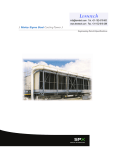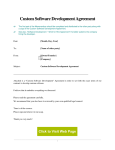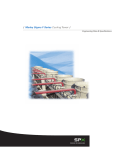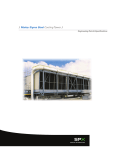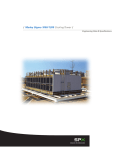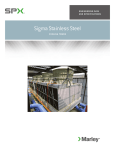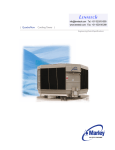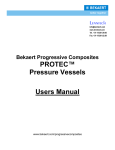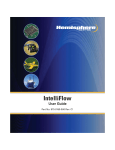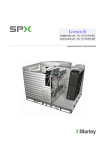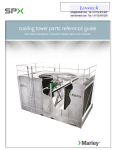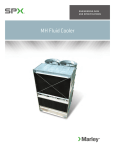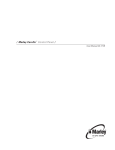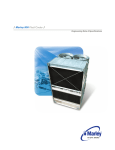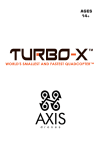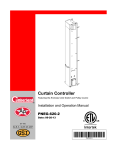Download Marley Sigma Stainless Steel Cooling Tower
Transcript
Lenntech [email protected] Tel. +31-152-610-900 www.lenntech.com Fax. +31-152-616-289 / Marley Sigma Stainless Steel Cooling Tower / Engineering Data & Specifications Marley / Sigma Stainless Steel Cooling Tower / Contents Engineering Data Schematic Support Concrete Basin Piping Environmental Energy Management 6 7 8 9 10 11 Specifications / Base Base Thermal Performance Construction Fan Deck and Fan Cylinder Mechanical Equipment Fill, Louvers and Drift Eliminators Hot Water Distribution System Casing Access Cold Water Collection Basin Scope of Work 12 13 14 15 15 17 18 18 18 19 19 Specifications / Options Control Options Control System Basin Heater Fan Motor Variable Speed Drive Marley Premium VFD System Vibration Limit Switch 20 21 21 22 23 Convenience and Safety Options Stairway Plenum Walkway Ladder Extension Ladder Safety Cage Oil Level Sight Glass 24 24 24 24 25 Miscellaneous Options Stainless Steel Cold Water Basin Factory Mutual Approval Hot Water Basin Covers Air Inlet Screens Low Noise Tower 25 25 25 25 26 Marley / Sigma Stainless Steel Cooling Tower / S igma Stainless Steel towers are field-erected, general purpose crossflow cooling towers, designed to serve all normal cooling water systems—as well as those systems whose water quality would jeopardize the life expectancy of a galvanized tower. In some locations, the quality of the circulating water is very poor. This can be because of the character of the makeup water (brackish, acidic, alkaline, etc.), or because of contamination by the product being cooled. In many cases, it is because of poor air quality at site. Being an ideal air washer, the cooling tower water soon mimics the quality of the air. In those locations where both air and water quality are corrosive in nature, the specifications for the Sigma Stainless Steel should not be compromised. This specification booklet gives you appropriate guidance in that respect. The left hand column of all pages provides text for the various specification paragraphs, whereas the right hand column comments on the meaning of the subject matter and explains its value. It also com- 5 ments on the logic of staying with stainless steel vs. shifting to galvanized steel for all the appropriate tower components. Pages 12 through 19 indicate those paragraphs which will result in the purchase of a tower that will not only accomplish the specified thermal performance, but will include normal operation and maintenance-enhancing features. Pages 20 through 26 provide some paragraphs intended to add those features and components that will customize the tower to meet the user's requirements. Space does not permit definition and explanation of all the possible options that can be applied to the Sigma Stainless Steel. SPX Cooling Technologies realizes that you, the purchaser, must be happy with the tower and its characteristics, and we are prepared to provide—or provide for—any reasonable enhancement that you are willing to define and purchase. Your needs will become part of the continuing improvement of this Marley product line. 6 W OUT-TO-OUT OF TOWER Marley / Sigma Stainless Steel Cooling Tower / Engineering Data : Schematic 41/2" CL COLUMN C DIAMETER FAN CL COLUMN A BAYS AT 4'-0" = L COLUMNCL 41/2" TOP OF FAN CYLINDER H The UPDATE web-based selection software —available at spxcooling.com—provides Sigma Steel model recommendations based on customer's specific design requirements. Tower Model GPM per cell FAN DECK B Use this data for preliminary layouts only. Obtain current drawing from your Marley sales representative. 13'-11/8" BASE OF TOWER COLUMNS Dimensions W L H A B C Maximum Motor hp Average Pumping Head 121-111 500-4500 25'-4" 12'-0" 19'-1 ⁄8" 3 6'-0" 120" 60 17.3' 122-111 650-6000 27'-4" 16'-0" 19'-11⁄8" 4 6'-0" 144" 60 17.4' 1 123-111 650-6000 29'-4" 16'-0" 20'-1 ⁄8" 4 7'-0" 168" 75 17.4' 124-111 1000-7500 29'-4" 20'-0" 20'-11⁄8" 5 7'-0" 168" 75 17.4' 125-111 1000-7500 33'-4" 20'-0" 20'-1 ⁄8" 5 7'-0" 216" 75 17.5' 126-111 1000-9000 33'-4" 24'-0" 20'-11⁄8" 6 7'-0" 216" 100 17.5' 127-111 1500-10500 33'-4" 28'-0" 20'-1 ⁄8" 7 7'-0" 216" 100 17.6' 1 1 1 NOTE 1 Use this bulletin for preliminary layouts only. Obtain current drawings from your Marley sales representative. 2 Last number of model indicates number of cells. Change as appropriate for your selection. Primary engineering data is per cell. 3 Height shown is from base of tower columns to top of fan cylinder. 4 Pumping head shown is from base of tower columns. Marley / Sigma Stainless Steel Cooling Tower / Engineering Data : Support A SPACES AT 4'-0" = L 6" AIR INLET FACE CASED ENDWALL FACE OVERFLOW RECOMMENDED OPERATING WATER LEVEL 1'-6" W OVERALL OF BASIN SUMP CASED ENDWALL FACE 6" Section AIR INLET FACE INTERMEDIATE BEAM PRIMARY SUPPORT BEAM Plan Tower Model Operating Weight lb Dimensions A W L Single Fan Cell Each Cell Add 121-111 3 23'-8" 12'-0" 37670 33150 122-111 4 25'-8" 16'-0" 49875 45105 123-111 4 27'-8" 16'-0" 50320 45230 124-111 5 27'-8" 20'-0" 60290 55200 125-111 5 31'-8" 20'-0" 67150 61220 126-111 6 31'-8" 24'-0" 77960 72115 127-111 7 31'-8" 28'-0" 88850 83590 NOTE 1 Use this bulletin for preliminary layouts only. Obtain current drawings from your Marley sales representative. 2 Steel beams must include 7⁄8" dia. holes to accept anchor bolts provided with tower. Other contractors or purchaser must design and erect supporting steel. 3 Maintain at least 2'-0" of clear space at tower endwalls for construction purposes. Air inlet faces must have unobstructed air supply. If obstructions exist nearby, consult your Marley sales representative. 4 Operating weight is wet weight of tower and steel basin, including 6" of water in the cold water basin. 5 View shown is typical single cell beam arrangement. 7 Marley / Sigma Stainless Steel Cooling Tower / Engineering Data : Concrete Basin W 6" MIN. 6" MIN. IN TO IN OF BASIN 6" MIN. 5" AIR INLET FACE ANCHOR BOLTS (SEE NOTE 5) SUMP A SPACES AT 4'-0" = L PER CELL AIR INLET FACE CASED ENDWALL FACE CASED ENDWALL FACE 6" MIN. 5" Plan RECOMMENDED OPERATING WATER LEVEL 1'-6" 1'-0 Section Tower Model Operating Weight lb Dimensions A W L Single Fan Cell Each Cell Add 121-111 3 23'-6" 12'-0" 25200 21525 122-111 4 25'-6" 16'-0" 32280 28430 123-111 4 27'-6" 16'-0" 33300 29080 124-111 5 27'-6" 20'-0" 39230 35025 125-111 5 31'-6" 20'-0" 42800 37715 126-111 6 31'-6" 24'-0" 48780 43910 127-111 7 31'-6" 28'-0" 54830 50550 NOTE 1 Use this bulletin for preliminary layouts only. Do not use for construction. Obtain current drawings from your Marley sales representative. Concrete basin design and construction are by other contractors or purchaser. 2 Operating weight is total wet operating weight of tower only, excluding water in concrete basin. 3 Maintain at least 2'-0" of clear space at tower endwalls for construction purposes. Air inlet faces must have unobstructed air supply. If obstructions exist nearby, consult your Marley sales representative. 4 Minimum basin depth is 1'-6". Basin depth may vary to suit your storage requirements. 5 All anchor bolts complete with nut and washer must be furnished by others. Bolts must be 3⁄4" diameter with 11⁄2" all-thread projection. 6 Other contractors or purchaser must design, locate, construct, and furnish sump(s) and overflow(s) to suit requirements. The sump(s) should be designed according to the pump manufacturer’s recommendations. Other design sources: ANSI/HI specifications 1.1-1.5 for centrifugal pumps, 2.1-2.5 for vertical pumps, and 9.8 for pump intake design. 8 Marley / Sigma Stainless Steel Cooling Tower / Engineering Data : Inlet Piping C CL FAN CL INLET D CL FAN CL INLET TYP. MULTICELL C CL COLUMN AND ANCHOR BOLT CL F MIN REQUIRED CLEARANCE TYP. SINGLE CELL CL COLUMN AND ANCHOR BOLT B DIA FLOW FACE OF A DIA INLET FLANGE E CL FAN CL TOWER MARLEY PIPING STOPS HERE CL CONTROL VALVE G CL OF FLANGE TO BASE OF TOWER COLUMNS (USE FOR STATIC LIFT) Tower Model GPM per cell Dimensions A B 500-3800 10" 8" 3801-4500 12" 10" 122-111 650-6000 14" 123-111 650-6000 121-111 C D E F 8'-10 ⁄2" G 1 14'-63⁄4" 6'-0" 12'0" 10" 8'-0" 16'-0" 10'-0 ⁄2" 14'-1 ⁄4" 14'-73⁄4" 14" 10" 8'-0" 16'-0" 11'-01⁄2" 15'-11⁄4" 14'-73⁄4" 1000-6000 14" 10" 6001-7500 16" 12" 125-111 1000-7500 16" 126-111 1000-9000 127-111 1500-10500 124-111 9'-01⁄2" 1 11'-0 ⁄2" 13'-11⁄4" 1 1 15'-11⁄4" 14'-73⁄4" 14'-73⁄4" 10'-0" 20'-0" 12" 10'-0" 20'-0" 13'-1 ⁄2" 17'-1 ⁄4" 14'-83⁄4" 16" 12" 12'-0" 24'-0" 13'-11⁄2" 17'-11⁄4" 14'-83⁄4" 18" 14" 14'-0" 28'-0" 13'-5 ⁄8" 17'-1 ⁄4" 14'-93⁄4" 11'-11⁄2" 1 5 1 1 14'-83⁄4" NOTE 1 Use this bulletin for preliminary layouts only. Obtain current drawings from your Marley sales representative. 2 Pumping head contributed by the tower is static lift “G”. Actual pumping head will vary according to tower circulating GPM. Total pumping head will be furnished at time of proposal. 3 If your application requires a bypass system, recommended location is through tower endwall into plenum area. Review of the system by SPX engineering is required. 4 Marley piping terminates at face of a cast iron flat face flange. Bolt circle conforms to class 125 lb. ANSI B 16.1 specifications. 5 Supports on tower for crossover piping are part of the tower design. Do not support the riser’s dead load or operating load from the tower. Do not brace the riser’s seismic or thrust loads against the tower. 6 Butterfly valves or piping expansion joints (if used) are by others and must be located outside the limits of the cooling tower “F”. 7 Motor must be located 180° from inlet. 9 Marley / Sigma Stainless Steel Cooling Tower / Environmental 10 Sound Control Sound produced by a Sigma Steel tower operating in an unobstructed environment will meet all but the most restrictive noise limitations—and will react favorably to natural attenuation. Where the tower has been sized to operate within an enclosure, the enclosure itself will have a damping effect on sound. Sound also declines with distance—by about 5 dBA each time the distance doubles. Where noise at a critical point is likely to exceed an acceptable limit, several options are available—listed below in ascending order of cost impact: • Inmanycases,noiseconcernsarelimitedtonighttime, when ambient noise levels are lower and neighbors are trying to sleep. You can usually resolve these situations by using two-speed motors in either 1800/900 or 1800/1200 RPM configuration—operating the fans at reduced speed without cycling “after hours”. The natural nighttime reduction in wet-bulb temperature makes this a very feasible solution in most areas of the world, but the need to avoid cycling may cause the cold water temperature to vary significantly. • TheMarleyVariableFrequencyDriveautomaticallyminimizes the tower’s noise level during periods of reduced load and/or reduced ambient temperature without sacrificing the system’s ability to maintain a constant cold water temperature. This is a relatively inexpensive solution, and can pay for itself quickly in reduced energy costs. • Wherenoiseisaconcernatalltimes—forexample, near a hospital—the best solution is to oversize the tower so it can operate continuously at reduced (1200 or 900 RPM) motor speed. Typical sound reductions are 7 dBA at 2/3 fan speed or 10 dBA at half fan speed. • Extremecasesmayrequireinletanddischargesound attenuator sections—however, the static pressure loss imposed by attenuators may necessitate an increase in tower size. This is the least desirable approach because of the significant cost impact—and because of the obstruction to normal maintenance procedures. As suggested in the aforementioned Technical Report, it may also be advisable to specify a design wet-bulb temperature 1°F higher than normal to compensate for potential recirculation initiated by the enclosure. You’ll benefit from discussing your project with your Marley sales representative. Keeping It Clean Cooling towers are very effective air washers. Atmospheric dust able to pass through the relatively small louver openings will enter the circulating water system. Increased concentrations can intensify system maintenance by clogging screens and strainers—and smaller particulates can coat system heat transfer surfaces. In areas of low flow velocity— such as the cold water basin—sedimentary deposits can provide a breeding ground for bacteria. In areas prone to dust and sedimentation, you should consider installing some means for keeping the cold water basin clean. Typical devices include side stream filters and a variety of filtration media. Water Treatment Contaminants including Legionella, an effective consistent water treatment program is required. Controlling blowdown may be adequate in mitigating the potential of corrosion and scale, but biological contamination can only be controlled with biocides. An acceptable water treatment program must be compatible with the variety of materials incorporated in a cooling tower—ideally the pH of the circulating water should fall between 6.5 and 8.0. Batch feeding of chemicals directly into the cooling tower is not a good practice since localized damage to the tower is possible. Specific startup instructions and additional water quality recommendations can be found in the Sigma User Manual which accompanies the tower and also is available from your local Marley sales representative. For complete water treatment recommendations and services, contact your local Marley sales representative. Your Marley sales representative will help you meet your sound requirements. Enclosures Occasionally, cooling towers are located inside architectural enclosures for aesthetic reasons. Although Sigma towers adapt well to enclosures, the designer must realize the potential impact of a poorly arranged enclosure on the tower’s performance and operation. The designer must take care to provide generous air inlet paths, and the tower’s fan cylinder discharge height should not be lower than the elevation of the top of the enclosure. Obtain a copy of Marley Technical Report #H-004, “External Influences on Cooling Tower Performance” from your Marley sales representative or on the web at spxcooling.com. CAUTION The cooling tower must be located at such distance and direction to avoid the possibility of contaminated discharge air being drawn into building fresh air intake ducts. The purchaser should obtain the services of a Licensed Professional Engineer or Registered Architect to certify that the location of the cooling tower is in compliance with applicable air pollution, fire and clean air codes. Marley / Sigma Stainless Steel Cooling Tower / Energy Management 11 Cooling towers are usually selected to produce a specific cold water temperature at the higher summertime wet-bulb temperatures. During the remainder of the year, the cooling tower is capable of producing much colder water. Unless your system will benefit from the coldest possible water temperature, you should consider controlling cold water temperatures to higher levels. You’ll also save energy by using such control. For greater insight on cold water temperature control, please read “Cooling Tower Energy and its Management”, Technical Report #H-001A, available from your Marley sales representative or on the web at spxcooling.com. Normally, two-speed motors are provided in 1800/900 RPM, single winding configuration, which is the least expensive two-speed option. They are also available in other combinations including the more expensive double winding. Variable Speed Fan Drive Always control leaving water temperature by manipulating the quantity of air that the fan moves through the tower. Varying the quantity of water flow is not normally recommended and can be harmful in freezing weather. You can alternately start and stop single-speed motors to maintain water temperatures within an acceptable range. However, exceeding a total acceleration time of 30 seconds per hour can overheat the motor, causing the insulation to fail. Limiting the number of motor starts, on the other hand, can produce significant variations in the temperature of the water delivered to the process. Marley VFD drive systems are designed to combine absolute temperature control with ideal energy management. The cooling tower user selects a cold water temperature and the drive system will vary the fan speed to maintain that temperature. Precise temperature control is accomplished with far less stress to the mechanical equipment components. The improved energy management provides fast payback. Indeed, many utilities offer generous rebates for users having installed VFD drives. Increased flexibility can simplify your operating procedures and save you money in the long run, both on operation and on maintenance. Here are two of the more popular options. Two-Speed Motors Two-speed motors improve operating flexibility by increasing the number of potential operating modes. Users in northern climates will find that the tower can carry winter loads at half-speed; reducing fan power requirements by 85+% during that time. Two-speed motors also help to control icing during wintertime operation. See Marley Technical Report #H-003, “Operating Cooling Towers During Freezing Weather”, available from your Marley sales representative or on the web at spxcooling.com. Frequency modulation devices work well on induced draft, propeller fan cooling towers such as the Sigma Steel cooling tower. However, their design must include the capability to lock out any critical fan speeds and the very low fan speed ranges. Marley / Sigma Stainless Steel Cooling Tower / Specifications: Base Specifications 1.0 Base: 1.1 Furnish and install an induced-draft, crossflow-type, field-erected, stainless steel-framed, PVC-fill, industrialduty cooling tower of _____ cell(s), as shown on Plans. The limiting overall dimensions of the tower shall be _____ wide, _____ long, and _____ high to the top of the fan cylinder. Total operating horsepower of all fans shall not exceed ____ hp, consisting of ___ @ _____ hp motor(s). Tower shall be similar and equal in all respects to Marley Model _______. 12 Specification Value ■ Your specification base establishes the type, configuration, base material, and physical limitations of the cooling tower to be quoted. During the planning and layout stages of your project, you will have focused your attention on a cooling tower selection that fits your space allotment, and whose power usage is acceptable. Limitations on physical size and total operating horsepower avoid the introduction of unforeseen operational and site-related influences. Specifying the number of cells, and the maximum fan hp/cell will work to your advantage. Crossflow towers are noted for the accessibility and maintainability of all operating components. The spacious interior provides easy access to fill, drift eliminators, all basin accessories — and is one of two primary access ways to the fan, Geareducer, and other mechanical components. At the fan deck level, the hot water distribution basins are easily inspected and cleaned — while the tower is operating, if you wish. The mechanical equipment can also be readily accessed from this level. Except for the cold water basin, no counterflow tower component requiring routine maintenance is as easily accessed. The confined areas that typify counterflow designs can make difficult work for maintenance personnel! Marley / Sigma Stainless Steel Cooling Tower / Specifications: Base Specifications 2.0 Thermal Performance: 2.1 The tower shall be capable of cooling _____ GPM of water from ____ °F to _____ °F at a design entering air wetbulb temperature of _____ °F. The cooling tower manufacturer shall guarantee that the tower supplied will meet the specified performance conditions when the tower is installed according to plans. Specification Value ■ Your reason for purchasing a cooling tower is to obtain a continuing flow of cooled water as defined in the first paragraph at left. If the tower that you purchase is incapable of performing as specified, then you will not have received full value for your money. Bear in mind that the size—and cost—of a cooling tower varies directly with its true thermal capability. This paragraph is intended to protect you against either intentional or inadvertent under sizing of the tower by the manufacturer. Judging the level of performance of a cooling tower on critical processes is never easy, and the potential risk of a nonperforming cooling tower usually causes the requirement for a mandatory acceptance test to be very desirable. The purchaser will arrange for an on-site thermal performance test, to be conducted in the presence of the manufacturer and owner, and under the supervision of a qualified, disinterested third party in accordance with CTI (Cooling Technology Institute) ATC105 standards during the first full year of operation. If the tower fails to perform within the limits of test tolerance, then the cooling tower manufacturer will install additional cells and/or make such corrections as are agreeable to the owner and shall pay for the cost of a retest. If the tower still fails to perform as specified, then the manufacturer shall make such reimbursements as are appropriate and agreeable to the owner to compensate for the performance deficiency. Your contract with the successful bidder should establish the acceptable remedies for missed performance, which might include: • The addition of one or more cells of tower, as necessary, to bring the cooling tower to the specified level of performance. This is usually limited to the scope of work as defined in the specs, which means that you (the owner) will have to pay for the additional basin, wiring, starters, piping, etc. • The reimbursement of a portion of the total contract price equal to the percentage deficiency in performance. Under no circumstances should you allow the manufacturer to re-pitch the fans to increase motor brake horsepower above that shown in the proposal. That creates additional operating costs that will continue for the life of the tower—and imposes no penalty on the manufacturer. 95° 90° 85° COLD WATER TEMP. (°F) 2.2 13 80° 5°F RANGE 10°F RANGE 15°F RANGE 75° 70° 65° 60° 55° 50° 55° 60° 65° 70° WET BULB TEMP. (°F) Typical cooling tower performance curve. 75° 80° Marley / Sigma Stainless Steel Cooling Tower / Specifications: Base Specifications 3.0 Construction: 3.1 The tower shall be capable of withstanding water having a pH of 6.5 to 8.0; a chloride content (NaCl) up to 750 ppm; a sulfate content (SO4 ) up to 1200 ppm; a calcium content (CaCO3) up to 800 ppm; silica (SiO2) up to 150 ppm; and design hot water temperatures up to 120°F. The circulating water shall contain no oil, grease, fatty acids, or organic solvents. 3.2 The structural framework of the tower, as well as all basins and decking, shall be of heavy gauge cold-formed and/or mill shapes of stainless steel. All stainless steel shall be series 300 except for tap screws. Tap screws may be series 431 stainless. 3.3 Column lines shall be on no greater than 4'-0" longitudinal centers, and the base of all columns shall be firmly anchored. Basic design criteria shall be 30 psf wind load and 5%g seismic load. Framing joints shall be made with 1/2" diameter and larger stainless steel machine bolts. 3.4 Towers of more than one cell shall include stainless steel internal partitions to separate the fan plenums, and a hinged access door shall be provided in each partition for freedom of access throughout the tower. 14 Specification Value ■ For pure resistance to corrosion—coupled with the capability to meet stringent fire and building codes—there is no substitute for stainless steel! No paints or electrostatically-applied coatings, however exotic they may be, can match stainless steel's ability to withstand adverse operating conditions. Although many structural FRP components are used in various other Marley product lines, they are held to a relative minimum in the Sigma Stainless Steel line. This is to assure that there will be no question as to the structural integrity, fire resistance, and life expectancy in the mind of the owner. Except for those unusual operating situations where the circulating water may be so laden with suspended solids, algae, fatty acids, product fibers, active organisms reflected in BOD, and the like that plugging of film type fill is a probability, the Sigma Stainless Steel is relatively immune to poor water quality. Where such conditions do exist, however, thought should be given to the prevention of such carryover—or to the use of one of the Marley splash-fill product lines. Please discuss your situation with your Marley sales representative. ■ Multicell towers must have plenum partitions between cells. Otherwise, air will be induced downward through an inoperative fan, bypassing the fill entirely. Without these partitions, part-load or off-season operation of the tower would be completely unsatisfactory. Marley / Sigma Stainless Steel Cooling Tower / Specifications: Base Specifications 15 Specification Value 4.0 Fan Deck and Fan Cylinder: 4.1 The fan deck shall act as a working platform for maintenance personnel. It shall be fabricated of no less than 12 gauge stainless steel, and shall be designed for a uniform live load of 60 psf. ■ The indicated design values for framing and decking not only give you assurance that the tower can withstand long term operation in a hostile environment—but that it will accept many years of inspection and maintenance traffic by your operating personnel. 4.2 Fan cylinders shall be molded FRP. They shall be through-bolted to the fan deck structure and framing to provide a consistently stable operating shroud for the fan. ■ Fiberglass-reinforced polyester fan cylinders provide the close tip clearances and smooth airflow contour necessary for good fan performance. The inert, noncorroding nature of FRP assures that these characteristics will persist. Their 6'-0" to 7'-0" height also provides protection for operating personnel. 5.0 Mechanical Equipment: 5.1 Fan(s) shall be propeller-type, incorporating heavy duty blades of cast aluminum or high strength, inert composite material. Blades shall be individually adjustable and replaceable. Fan(s) shall be driven through a rightangle, industrial-duty, oil-lubricated, geared speed reducer. Speed reducers employing pulleys and belts will not be accepted. ■ Propeller-type fans require only half the operating hp of blower-type fans. Fans should be readily adjustable to permit compensation for job site conditions that may tend to overload the motor. The fans of one manufacturer require the purchase of special positioners for each increment of fan blade pitch. Motor(s) shall be ____ hp maximum, TEFC,1.15servicefactor,andspecially insulated for cooling tower duty. Speed and electrical characteristics shall be 1800 (1800/900) RPM, single winding, ___ phase, ___ hertz, ___ volts. ■ Unless otherwise specified, motor speed will be 1800 RPM in 60 Hertz areas and 1500 RPM in 50 Hertz areas. If you prefer the operating flexibility of two-speed operation, please specify the RPM to be 1800/900 (1500/750 in 50 Hertz regions). 5.2 Standard fan drives of other manufacturers may use V-belts. Considering the size of fans involved—and the horsepower applied— this is not good design practice. Geareducer drive is far more reliable and trouble free, and is currently offered as an option by at least two other cooling tower manufacturers. Marley / Sigma Stainless Steel Cooling Tower / Specifications: Base Specifications 5.3 Motor shall be located outside the fan cylinder at the fan deck, and shall be connected to the speed reducer by a tubular stainless steel, dynamically balanced driveshaft equipped with neoprene flexible coupling elements. 16 Specification Value ■ The driveshaft turns at the motor speed and is, therefore, most sensitive to operational imbalance. Stainless steel manufacture assures that the driveshaft will not become unbalanced as a result of corrosion. 5.4 An oil gauge and stainless steel drain line shall extend from the gear reducer to the vicinity of the motor, and shall be equipped with a dip stick for oil level measurement. 5.5 The complete mechanical equipment assembly for each cell shall be supported by a rigid, unitized support that resists misalignment between the motor and the gear reducer. Support shall be heavy-wall tubular stainless steel, to which heavy plate platforms for the motor and gear reducer have been welded. The support assembly shall also provide an inlet connection for incoming hot water, and shall serve as a crossover pipe to deliver water to both sides of the tower. ■ Fans of the size used on large cooling towers are applied at speeds and horsepower that generate considerable torque—and structural tubular steel resists this torque very effectively. The Marley torque-tube assures that all of the mechanical equipment remains aligned, and that the rotating fan is properly positioned within the fan cylinder. 5.6 The mechanical equipment assembly shall be warranted for no less than five (5) years. This warranty shall cover the fan(s), speed reducers, driveshafts and couplings, and the unitized supports. ■ The value of a 5 year mechanical equipment warranty speaks for itself. Except for the motor, all of the mechanical equipment on a Marley tower is made by SPX Cooling Technologies. Cooling tower vendors who purchase commercial fans, gear boxes, driveshafts, etc. may require that you deal directly with those commercial suppliers for warranty satisfaction. Marley / Sigma Stainless Steel Cooling Tower / Specifications: Base 17 Specification Value Specifications 6.0 Fill, Louvers and Drift Eliminators: 6.1 Fill shall be film-type, 15 mil thick, thermoformed PVC, with louvers formed as part of each fill sheet. Fill shall be suspended from stainless steel structural tubing supported from the upper tower structure, and shall be elevated above the floor of the cold water basin to facilitate cleaning. Air inlet faces of the tower shall be free of water splash-out. ■ Louvers integral with the fill keep the flowing water within the confines of the fill. The separate external louvers used by others permit water to escape the fill and form ice or produce an unsightly situation adjacent to the tower. If you plan to use your tower in the wintertime, particularly for free cooling, integral louvers will put your operating concerns to rest. 6.2 Drift eliminators shall be PVC, triplepass, and shall limit drift losses to 0.005% or less of the design water flow rate. ■ Vertical blade-type eliminators, as well as misdirected cellular types, cause much of the fan power to be wasted in turning the horizontal flow of air vertical for its exit through the fan cylinder. This power is, of course, not available for contribution to thermal performance. Drift rate varies with design water loading and air rate, as well as drift eliminator depth and number of directional changes. A drift rate of 0.001% is readily available in standard configuration without premium cost. If a lower rate is required, please discuss with your Marley sales representative. Drift Eliminator Section Louver Section Fill Section Marley / Sigma Stainless Steel Cooling Tower / Specifications: Base 18 Specification Value Specifications 7.0 Hot Water Distribution System: 7.1 The mechanical equipment support/ crossover pipe shall deliver water to two open hot water basins per cell at the fan deck elevation. Water shall exit these basins to the fill by gravity through metering orifice-type polypropylene nozzles situated in the basin floor. Nozzles shall be easily removable and replaceable. ■ Gravity-flow distribution basins are a feature of crossflow type towers. These basins are out where they can be easily inspected—even maintained—while the tower is in operation. Spray systems of counterflow towers, sandwiched between the top of the fill and the drift eliminators, are extremely awkward to access and maintain. 7.2 Heavy-duty, industrial grade flowcontrol valves shall be provided at the inlet to each basin. These valves shall permit both flow balancing and maintenance shut-off to selected cells, or portions of cells. Valves shall have machined cast iron bodies, with stainless steel operating stems, and heavyduty locking handles. ■ Marley flow-control valves remain serviceable for the life of the tower, and provide a continuing means of flow-regulation between hot water basins—and between cells of multicell towers as well. Towers without valves do not provide this valuable operating flexibility. 8.0 Casing: 8.1 Tower endwalls shall be cased with corrugated FRP panels, attached with corrugations running vertically and overlapped one corrugation at joints. Tower corners shall be finished with FRP corner rolls over the ends of the casing sheets. 8.2 In the water-washed fill areas, inner casings of 16 gauge stainless steel shall also be provided. 9.0 Access: 9.1 There shall be a 33" wide by 61" high access door in each endwall casing to provide access to the interior of the tower. Access doors shall be hinged and equipped with a latch operable from both inside and outside the tower. Internal partitions between cells shall include hinged doors to give free access through the tower. ➠ ■ Stainless steel inner casings provide lateral support for the fill that FRP panels cannot. They also support the FRP casing panels against the high wind loads that will act on the tower during its lifetime. ■ The access doors on other towers may be unreasonably small. Specifying the size of the door will cause those bidders to take exception, alerting you to a potential maintenance headache. Marley / Sigma Stainless Steel Cooling Tower / Specifications: Base Specifications 19 Specification Value 9.2 The top of the tower shall be equipped with a sturdy 42" high guardrail system, complete with top rails, intermediate rails and toeboards, conforming to OSHA standards. Guardrails and posts shall consist of 2" stainless steel tubes. Posts shall be spaced on centers of 8'-0" or less. ■ Good maintenance practice requires periodic access to the top of the tower to inspect the distribution basins, as well as the structural integrity of the fan deck, fan cylinder, and fan — especially the fan blade securing hardware. There are no induced-draft cooling tower designs that are immune to this need! 9.3 One endwall of the tower shall be equipped with a 20" wide aluminum vertical ladder, through-bolted to the endwall structure. Ladder shall rise from the cold water basin level to the top of the fan deck guardrail, and shall be designed and installed in conformance with OSHA standards. ■ For the comfort and safety of your operating personnel, the Sigma Steel tower includes a ladder and guardrail of the quality and design indicated — and we strongly recommend that you require it of all bidders! Portable ladders and other "make-do" access means are inappropriate for equipment of this size and complexity. 10.0 Cold Water Collection Basin: 10.1 The cold water collection basin shall be of poured-in-place concrete, provided under the General Contractor's scope of work. The concrete basin design shall be based upon certified loads and dimensions provided by the cooling tower manufacturer. 11.0 Scope of Work: 11.1 The cooling tower manufacturer shall be responsible for the design, fabrication, and delivery of materials to the project site, and for the erection of the tower over supports provided by others. Unless otherwise specified, all external piping, pumps, controls, and electrical wiring will be outside the cooling tower manufacturer's scope of work. ■ This basic specification assumes that the tower will be erected over a concrete basin at grade level. If the tower is to be installed on an elevated supporting platform, the steel cold water collection basin indicated on page 24 should be included in the specifications. ■ Please be clear in your specifications and inquiry documents regarding the full scope of work expected. That will help assure that your bid comparisons will be made on as equal a basis as possible—and will help to avoid any misunderstandings during the execution and implementation of the contract. Marley / Sigma Stainless Steel Cooling Tower / Specifications: Options Specifications 20 Specification Value Control Options Control System: 5.7: Add the following paragraph in the Mechanical Equipment section: Eachcellofthecoolingtowershall be equipped with a UL listed control systeminaNEMA3Ror4Xoutdoor enclosure capable of controlling single-speed or two-speed motors as required, and designed specifically for cooling tower applications. The panel shall include a main fused disconnect with an external operating handle, lockable in the off position for safety. Across-the-line magnetic starters or solid state soft-start starters as required shall be controlled with a thermostatic or solid state temperature controller. Door mounted selector switches shall be provided to enable automatic or manual control and wired for 120VAC control. Control circuit to be wired out to terminal blocks for field connection to a remote vibration switch and for access to extra 120VAC 50VA control power, overload trip alarms and remote temperature control devices. The temperature controller shall be adjustable for the required cold water temperature. If a thermostatic controller is used it shall be mounted on the side of the tower with the temperature sensing bulb installed in the cold water basin using a suspension mounting bracket. If a solid state temperature controller is used the controller will be door mounted on the control panel. The temperature controller will display two temperatures, one for outgoing water and the other for set point. Water temperature input shall be obtained using a three-wire RTD with dry well in the outlet water piping and wired back to the solid state temperature controller in the control panel. ■ If it is your opinion that the control system for the cooling tower should be part of the tower manufacturer’s responsibility, we are in wholehearted agreement with you. Who better to determine the most efficient mode and manner of a tower’s operation—and to apply a system most compatible with it—than the designer and manufacturer of the cooling tower? Marley / Sigma Stainless Steel Cooling Tower / Specifications: Options Specification Value Specifications Basin Heaters: 10.2 21 Add the following paragraph in the Cold Water Basin section: Provide a system of electric immersion heaters and controls for each cell of the tower to prevent freezing of water in the collection basin during periods of shutdown. The system shall consist of one or more stainless steel electric immersion heaters installed in the basin. A NEMA4enclosureshallhouseamagnetic contactor to energize heaters; a transformer to provide 24 volt control circuit power; and a solid state circuit board for temperature and low water cutoff. A control probe shall be located in the basin to monitor water level and temperature. The system shall be capable of maintaining 40°F water temperature at an ambient air temperature of __ °F. ■ The basin heater components described at left represent our recommendation for a reliable automatic system for the prevention of basin freezing. They are shipped separately for installation at the job site. The ambient air temperature that you fill in should be the lowest 1% level of winter temperature prevalent at site. Fan Motor Variable Speed Drive: Marley All Weather ACH550 System 6.4 Add the following paragraph in the Mechanical Equipment section when VFD is used with customers Building Management System: A complete UL listed Variable Speed Drive system inaNEMA1indoor,NEMA12indoor orNEMA3Routdoorenclosureshall be provided. The VFD shall use PWM technology with IGBT switching and integrated bypass design. VFD out put switching shall not cause mechanical issues with gearbox teeth or drive shafts. The VFD shall catch a fan spinning in the reverse direction without tripping. The panel shall include a main disconnect with short circuit protection and external operating handle, lockable in the off position for safety. The VFD system shall receive a speed reference signal from the Building Management System monitoring the tower fluid temperature. As an option to receiving the speed reference signal from a building management system, the drive must have the capability to receive a 4-20 ma temperature signal from an RTD transmitter. The VFD shall have an internal PI regulator to modulate fan speed maintaining set ➠ ■ Marley VFD drive systems are designed to combine absolute temperature control with ideal energy management. The cooling tower user selects a cold water temperature and the drive system will vary the fan speed to maintain that temperature. Precise temperature control is accomplished with far less stress to the mechanical equipment components. The improved energy management provides fast payback. Indeed, many utilities offer generous rebates for users having installed VFD drives. Marley / Sigma Stainless Steel Cooling Tower / Specifications: Options Specifications point temperature. The drive's panel display shall be able to display the set-point temperature and cold-fluid temperature on two separate lines. The bypass shall include a complete magnetic bypass circuit and with capability to isolate the VFD when in the bypass mode. Transfer to the bypass mode shall be manual in the event of VFD failure. Once the motor is transferred to the by-pass circuit the fan motor will run at constant full speed. The bypass circuit will not modulate ON and OFF based on fluid temperature. The application must be able to handle very cold fluid temperatures while the VFD is in a by-pass mode. Operator controls shall be mounted on the front of the enclosure and shall consist of start and stop control, bypass/VFD selection, Auto/ Manual selections, manual speed control. To prevent heating problems in the fluid cooloer fan motor and to assure proper gear reducer lubrication the VFD system shall de energize the motor once 25% motor speed is reached and cooling is no longer required. The fluid cooler manufacturer shall supply VFD start-up assistance. Tower vibration testing throughout the speed range is required to identify and lockout any natural frequency vibration levels which may exceed CTI guidelines. Marley Premium VFD System 6.4 Add the following paragraph in the Mechanical Equipment section when VFD is used as a stand alone system: A complete UL listed Variable Speed DrivesysteminaNEMA12indoor orNEMA3Routdoorenclosureshall be provided. The VFD shall use PWM technology with IGBT switching and integrated bypass design. VFD output switching shall not cause mechanical issues with gearbox teeth or drive shafts. The VFD shall catch a fan spinning in the reverse direction without tripping. The panel shall include a main disconnect with short circuit protection and external operating handle, lockable in the off position for safety. The system shall include a solid state, PI temperature controller to adjust frequency output of the drive in response to the tower fluid temperature. The temperature of the fluid and set point shall be displayed on the door Specification Value 22 Marley / Sigma Stainless Steel Cooling Tower / Specifications: Options Specifications Specification Value of the control panel. The bypass shall include a complete magnetic bypass circuit with capability to isolate the VFD when in the bypass mode. Transfer to the bypass mode shall be automatic in the event of VFD failure or for specific trip conditions allowing safe transfer of utility voltage to the motor. Automatic bypass with an earth ground condition is not allowed. The bypass contactor shall be cycled on and off while operating in bypass, to maintain the set-point temperature of the cold water. The drive design shall be operated as a stand-alone system without the need for a BMS system. Operator controls shall be mounted on the front of the enclosure and shall consist of start and stop control, bypass/ VFD selector switch, Auto/Manual selector switch, manual speed control, and solid-state temperature controller. An emergency bypass selector switch internal to the panel allowing the fluid cooler fan motor to be run at full speed shall be furnished. To prevent heating problems in the fluid cooler fan motor and to assure proper gear box lubrication the VFD system shall de energize the motor once 25% motor speed is reached and cooling is no longer required. The VFD shall include de-icing logic with auto canceling and adjustable time. Speed in De-Ice mode shall not exceed 50% motor speed. The fluid cooler manufacturer shall supply VFD start-up assistance. Tower vibration testing throughout the speed range is required to identify and lockout any natural frequency vibration levels which may exceed CTI guidelines. Vibration Limit Switch: 5.8 Add the following paragraph in the Mechanical Equipment section: A single-pole, double-throw vibration limit switchinaNEMA4housingshallbe installed on the mechanical equipment support for wiring into the owner’s control panel. The purpose of this switch will be to interrupt power to the motor in the event of excessive vibration. It shall be adjustable for sensitivity, and shall require manual reset. ■ Unless specified otherwise, a Marly M-5 vibration switch will be provided. The requirement for manual reset assures that the tower will be visited to determine the cause of excessive vibration. 23 Marley / Sigma Stainless Steel Cooling Tower / Specifications: Options Specifications 24 Specification Value Convenience and Safety Options Stairway: 9.3 Replace paragraph 9.3 with the following: A 30" wide, 45° steel stairway with 8" rise and run, shall be provided at the tower endwall rising from grade (roof) to the fan deck elevation. Stair treads shall be bar grating with checker plate nosing, and shall be through bolted to structural channel stringers. Stairway posts and guardrails shall consist of 1.66" OD x 15 gauge mill-galvanized steel structural tubing. Structural steel support columns for the stairway shall be provided by the cooling tower manufacturer. Stairway foundation shall be by others, designed in accordance with drawings provided by the cooling tower manufacturer. The entire stairway shall be hot-dip galvanized and shall conform to OSHA standards. Plenum Walkway: 9.1 Add the following to the end of this paragraph: Provide a 30" wide bar grating walkway extending from one endwall access door to the other in each cell. This walkway shall be supported by a stainless steel framework, and the top of the grating shall be above the cold water basin overflow level. If the cold water basin is deeper than 4'-0", the walkway shall be equipped with guardrails. Ladder Extension: 9.4 Add the following paragraph in the Access and Safety section: Provide a ladder extension for connection to the base of the ladder attached to the tower casing. This extension shall be long enough to rise from the roof (grade) level to the base of the tower. Anchorage and lateral bracing of the ladder extension shall be by others. Ladder Safety Cage: 9.3 Add the following to the end of this paragraph: A heavy gauge stainless steel safety cage shall surround the ladder, extending from a point approximately 7'-0" above the base of the ladder to the top of the guardrail surrounding the fan deck. ■ Although they are not necessary for routine operation and maintenance, stairways do provide a safe and comfortable means of access to the top of the tower that is often overlooked in the initial cooling tower purchase. They are designed in straight-run or double-back configurations to accommodate your site requirements. ■ This option permits freedom of movement for inspection or maintenance within the tower without the need for wading boots or tower drainage. It also helps prevent maintenance personnel from damaging submerged accessories in the cold water basin (such as screens, probes, basin heaters, etc.). ■ Many towers are installed such that the base of the tower is 2'-0" or more above the roof or grade level. This makes it difficult to get up to the base of the attached ladder. The ladder extension alleviates this problem. Marley ladder extensions are available in standard 5'-0" and 11'-0" lengths, and will be field-cut to fit. ■ To meet OSHA guidelines, towers whose fan decks are 20'-0" or more above roof or grade, and which are equipped with ladders, are required to have safety cages surrounding the ladders. Marley / Sigma Stainless Steel Cooling Tower / Specifications: Options Specifications Oil Level Sight Glass: 5.4 Replace paragraph 5.4 with the following: An oil gauge and stainless steel drain line shall extend from the gear reducer to the vicinity of the motor, and shall be equipped with a bronze-bodied oil level sight glass. 25 Specification Value ■ The oil level sight glass is a convenience item that is preferred by many users. The same purpose is, of course, served by either the dip stick or the sight glass. Miscellaneous Options Stainless Steel Cold Water Basin: 10.1 Replace paragraph 10.1 with the following: Include a cold water collection basin constructed of 12 gauge formed stainless steel sheets. These sheets shall be bolted, gasketed and caulked to form a watertight basin 18" deep. A depressed, side outlet sump shall be included, having a 1/4" thick faceplate drilled for a standard 125# flange connection. An appropriately sized (3" diameter or larger) stainless steel or PVC standpipe overflow shall be provided. The standpipe shall be removable for flush-out cleaning of the basin. A float-operated, mechanical makeup valve shall also be included, installed adjacent to the endwall access door. Factory Mutual Approval: 3.5 Add the following paragraph in the Construction section: The tower shall include all design and material modifications necessary to meet the fire rating requirements of Factory Mutual. The product proposed shall be listed in the FM Approval Guide, latest edition. Hot Water Basin Covers: 7.3 Add the following paragraph to the Hot Water Distribution System Section: The distribution basins shall include stainless steel covers. These covers shall be designed for a uniform live load of 40 psf, and shall be easily removable for maintenance. Air Inlet Screens: 8.3 Add the following paragraph to the Casing Section: The air inlet faces of the tower shall be covered by 1" mesh stainless steel welded wire screens. Screens shall be mounted in stainless steel U-edging and shall be removable. ■ Marley basins are used to permit the installation of towers on elevated platforms or foundations. This is the simplest of several cold water basin designs available for the Sigma Stainless Steel towers. Marley can also install 10 gauge stainless steel basins of welded construction. The cold water basin is the only part of the tower that is subject to periods of stagnant water, concentrated with treatment chemicals and customary contaminants. It is also the most expensive and difficult part of any tower to repair or replace. For these reasons, SPX recommends that you stay with a basin of stainless steel construction. ■ This could have a very beneficial effect upon your fire insurance premiums. Towers not able to meet FM requirements may require the inclusion of a fire protection sprinkler system to achieve a comparable level of insurance premium cost. ■ These covers are designed to keep leaves and debris out of the circulating water system. They also serve to suppress algae formation by shielding the incoming hot water from direct sunlight. ■ In wooded or windy areas, these screens help to keep leaves or blowing debris out of the cooling tower and circulating water system. Marley / Sigma Stainless Steel Cooling Tower / Specifications: Options Specifications Low Noise Tower: 1.1 Add the following at the end of this paragraph: The cooling tower shall be quiet operating, and shall produce an overall level of sound no higher than ____ dBA at the critical location indicated on the Plans. 26 Specification Value ■ Sound produced by a Sigma Stainless Steel tower operating in an unobstructed environment will meet all but the most restrictive noise limitations – and will react favorably to natural attenuation. Where the tower has been sized to operate within an enclosure, the enclosure itself will have a damping effect on sound. Sound also declines with distance – by about 5 or 6 dBA each time the distance doubles. Where noise at a critical point is likely to exceed an acceptable limit, you have several options – listed below in ascending order of cost impact: • Where only a slight reduction in noise will satisfy — and the source of concern is in a particular direction — merely turning the tower may be the answer. Less sound emanates from the cased face of the tower than does from the air intake face. • In many cases, noise concerns are limited to nighttime, when ambient noise levels are lower and neighbors are trying to sleep. You can usually resolve these situations by using two-speed motors in either 1800/900 or 1800/1200 RPM configuration; and operating the fans at reduced speed without cycling “after hours”. (The natural nighttime reduction in wet-bulb temperature makes this a very feasible solution in most areas of the world, but the need to avoid cycling may cause the cold water temperature to vary significantly.) • Variable speed drives automatically minimize the tower's noise level during periods of reduced load and/or reduced ambient without sacrificing the system's ability to maintain a constant cold water temperature. This is a relatively inexpensive solution, and can pay for itself quickly in reduced energy costs. • Where noise is a concern at all times (for example, near a hospital), the best solution is to oversize the tower so it can operate continuously at reduced (1200 or 900 RPM) motor speed even at the highest design wet-bulb temperature. Typical sound reductions are 7 dBA at 2/3 fan speed or 10 dBA at 1/2 fan speed, but larger reductions are often possible. • Extreme cases may require inlet and discharge sound attenuator sections; however, the static pressure loss imposed by attenuators may necessitate an increase in tower size. This is the least desirable approach because of the significant cost impact – and because of the obstruction to normal maintenance procedures. Your Marley representative can help you meet your sound requirements. Lenntech [email protected] Tel. +31-152-610-900 www.lenntech.com Fax. +31-152-616-289 7401 WEST 129 STREET OVERLAND PARK, KANSAS 66213 UNITED STATES 913 664 7400 [email protected] spxcooling.com In the interest of technological progress, all products are subject to design and/or material change without notice. ©2010 SPX Cooling Technologies, Inc. Printed in USA | SS-SIG-TS-10



























